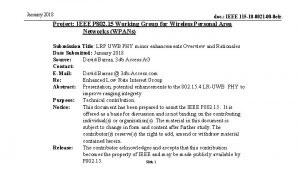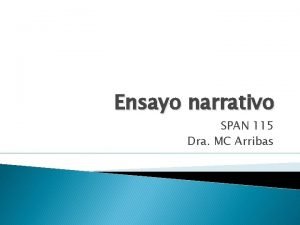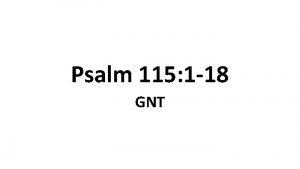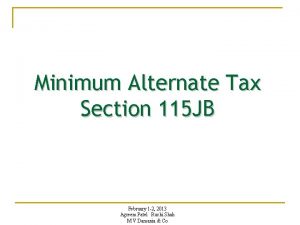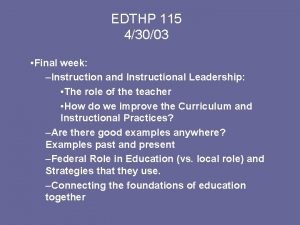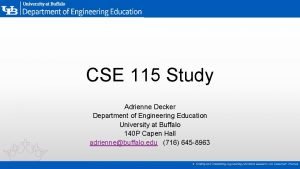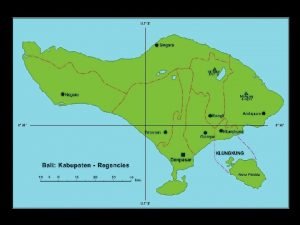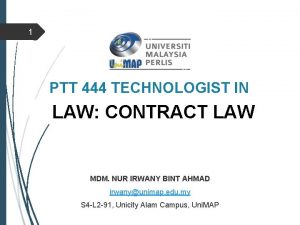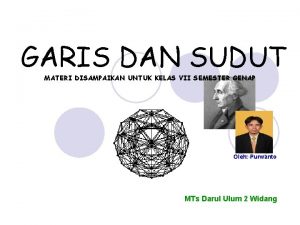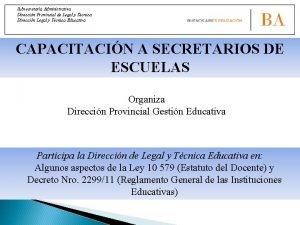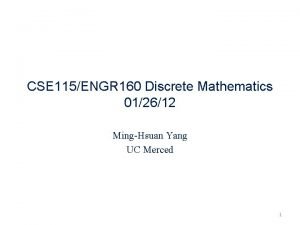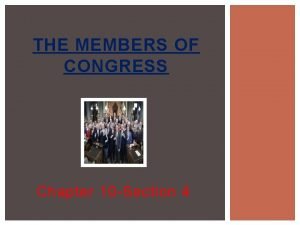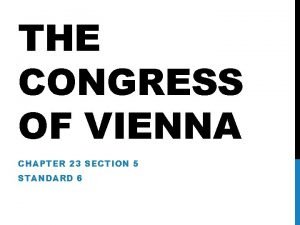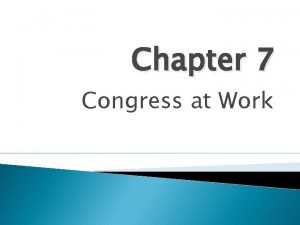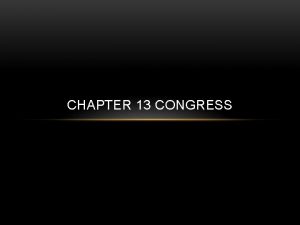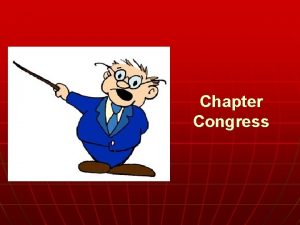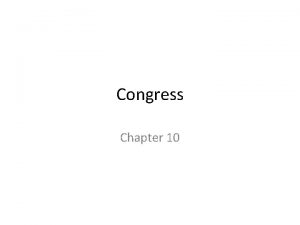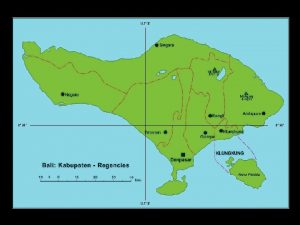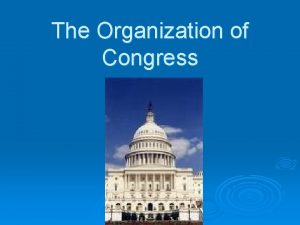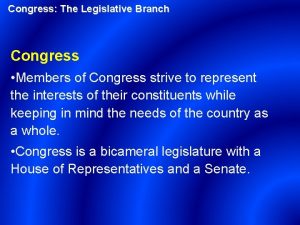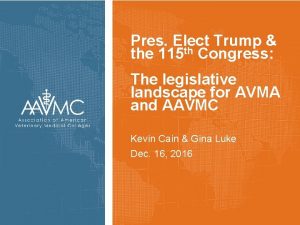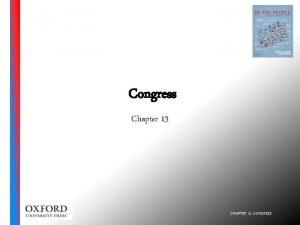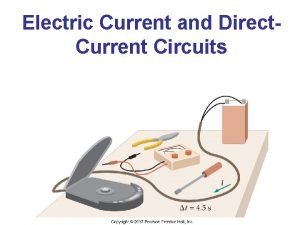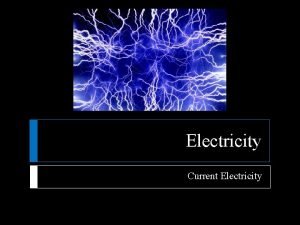CHAPTER 12 CONGRESS 115 th Congress Current meeting











![RACE [2010 Census figures in red] • There are 52 African American Members in RACE [2010 Census figures in red] • There are 52 African American Members in](https://slidetodoc.com/presentation_image/4d4c6a7e5df12ab1369f149f99a9ae15/image-12.jpg)





































- Slides: 49

CHAPTER 12 CONGRESS

115 th Congress - Current meeting of the legislative branch of the United States federal government, composed of the Senate and the House of Representatives. It meets in Washington, D. C. from January 3, 2017, to January 3, 2019.

The House of Representatives • In the House of Representatives there are 239 Republicans, 194 Democrats, and 2 vacant seats. • There are 5 delegates representing the District of Columbia, the Virgin Islands, Guam, American Samoa, and the Commonwealth of the Northern Mariana Islands. A resident commissioner represents Puerto Rico. They possess the same powers as other members of the House, except that they may not vote when the House is meeting as the House of Representatives. [total = 6 non-voting members] • Representatives represent about 710, 000 people each and serve 2 year terms.

The Senate • The Senate has 46 Democrats, 52 Republicans, and 2 Independents, who caucus with the Democrats – A senator represents between 1 and 37 million people, depending on their state’s population. Senators serve staggered 6 year terms.

• The annual salary of each Representative is $174, 000. The Speaker of the House earns more: $223, 500 [Paul Ryan] • $193, 400 for their party leaders (the same as Senate leaders). • A cost-of-living-adjustment (COLA) increase takes effect annually unless Congress votes to not accept it. • Congress sets members' salaries; however, the 27 th Amendment to the United States Constitution prohibits a change in salary (but not COLA) from taking effect until after the next election of the whole House. Representatives are eligible for retirement benefits after serving for five years. Outside pay is limited to 15% of congressional pay.

REPRESENTATION Does Congress/our representatives need to be DESCRIPTIVE in order to be SUBSTANTIVE?

AGE • The average of Members of the House at the beginning of the 112 th Congress was 57. 8 years; and of Senators, 61. 8 years. • U. S. = 36. 8 years

EDUCATION • The vast majority of Members (94. 1% of House Members and 100% of Senators) hold bachelor’s degrees. • 18 Members of the House and Senate have no degree beyond a high school diploma. • Law degrees are held by 167 Members of the House (38%) and 55 Senators (55%). • U. S. (aged 25+) = 32%

BACKGROUND/EMPLOYMENT • Law is the dominantly declared profession of Senators, followed by public service/politics, then business; • For Representatives, business is first, followed by public service/politics, then law.

RELIGION (numbers for 112 th) • 57% of the Members (248 in the House, 56 in the Senate) are Protestants. U. S. = 51. 3% • 29% percent of the Members (132 in the House, 24 in the Senate) are Catholic. U. S. = 23. 9% • 115 th: 90. 7% Christian • 7% of the Members (27 in the House, 12 in the Senate) are Jewish. U. S. = 1. 7% • Other religious affiliations represented in the 112 th Congress include Greek Orthodox, Quaker, Unitarian Universalist, and The Church of Jesus Christ of Latter. Day Saints (Mormon). There also three Buddhists and two Muslims, all serving in the House.

SEX • 109 women (20. 1% of the total membership) serve in the 115 th Congress. • U. S. = 50. 7% ORIENTATION/GENDER IDENTITY • 7 members of 115 th Congress are openly LGBTQ
![RACE 2010 Census figures in red There are 52 African American Members in RACE [2010 Census figures in red] • There are 52 African American Members in](https://slidetodoc.com/presentation_image/4d4c6a7e5df12ab1369f149f99a9ae15/image-12.jpg)
RACE [2010 Census figures in red] • There are 52 African American Members in the 115 th Congress (9. 6%); 12. 6% • 45 Latino (8. 3%); 16. 3% • 18 Asian/South Pacific (3. 3%); 5. 0% • 2 Native American (0. 37%); 0. 9% • Remaining 418 White (77. 3%); 72. 4%

• In 2013 Senator Tim Scott of South Carolina took the senatorial oath, the first African American senator since Reconstruction to represent a southern state. • When the governor of Massachusetts appointed William "Mo" Cowan on February 1, 2013, to fill a Senate vacancy, this marked the first time in history that two African American senators served simultaneously. • Senator Cowan served just a short appointed term, but in October of 2013 Senator Cory Booker of New Jersey won a Senate seat in a special election and joined Senator Scott in the 113 th Congress.

TIM SCOTT, SC (R) CORY BOOKER, NJ (D)

RACE: LATINO/HISPANIC • There are 31 Hispanic or Latino Members in the 112 th Congress, 5. 7% of the total membership. (Same for 113 th). • 29 serve in the House and 2 in the Senate. • U. S. = 16. 3% [12 Asian American/Pacific Islander]

VETERANS • 118 Members (21. 8% of the total membership) • U. S. = 7. 2%

SUMMARY …

Congress looks like …

WHILE THE U. S. IS …

The House of Representatives • a. The House is more institutionalized than the Senate meaning it is more hierarchical • b. Party loyalty to leadership and party-line voting are more common in the House (since there are more members – leaders do more leading) • c. House Rules Committee: unique committee in the House that reviews most bills coming from a House committee before they go to the full House – 1. Each bill is given a “rule” which schedules the bill on the calendar, allots time for debate, and sometimes even specifies what kind of amendments may be offered (speaker appoints members) d. House can impeach officials and all revenue bills must start there

House Speaker: Paul Ryan (R) • Majority (Republican) leadership Majority Leader: Kevin Mc. Carthy Majority Whip: Steve Scalise • Minority (Democratic) leadership Minority Leader: Nancy Pelosi Minority Whip: Steny Hoyer Assistant Minority Leader: Jim Clyburn [A whip is an official of a political party whose task is to ensure party discipline in a legislature. Whips are the party's "enforcers”; they invite their fellow legislators to attend voting sessions and to vote according to the official party policy. ]

The Senate • Since the Senate is smaller it is less disciplined and less centralized • Committees and the party leadership are important in determining the Senate legislative agenda 1. The party leaders do for scheduling what the Rules Committee does in the House • Filibuster: a strategy unique to the Senate whereby opponents of a piece of legislation try to talk it to death, based on the tradition of unlimited debate 1. Cloture: today 60 members can vote to stop a filibuster

Senate President: Mike Pence (R) Under the Constitution, the vice president serves as President of the Senate. He or she may vote in the Senate in the case of a tie, but is not required to. For much of the nation's history the task of presiding over Senate sessions was one of the vice president's principal duties (the other being to receive from the states the tally of electoral ballots cast for president and vice president and to open the certificates "in the Presence of the Senate and House of Representatives, " so that the total votes could be counted). Since the 1950 s, vice presidents have presided over few Senate debates. Instead, they have usually presided only on ceremonial occasions, such as swearing in new senators, joint sessions, or at times to announce the result of significant legislation or nomination, or when a tie vote on an important issue is anticipated. John Nance Garner III (D-TX), was the 39 th Speaker of the United States House of Representatives from 1931 to 1933. He was also the 32 nd Vice President of the United States, serving from 1933 to 1941 (under FDR as President). The Vice-Presidency was “Not worth a bucket of warm piss” - Comment to Lyndon B. Johnson on the vice presidency “Worst damnfool mistake I ever made was letting myself be elected Vice President of the United States. Should have stuck with my old chores as Speaker of the House. I gave up the second most important job in the Government for one that didn't amount to a hill of beans. I spent eight long years as Mr. Roosevelt's spare tire. I might still be Speaker if I didn't let them elect me Vice-President. ”

Senate President pro tempore: Orrin Hatch (R) (Latin for "president for a time”) - presides over the chamber in the vice president's absence, and is, by custom, the senator of the majority party with the longest record of continuous service. Like the vice president, the president pro tempore does not normally preside over the Senate, but typically delegates the responsibility of presiding to a majority-party senator who presides over the Senate PARTY LEADERS: Each party elects Senate party leaders. Floor leaders act as the party chief spokesmen. The Senate Majority Leader is responsible for scheduling debates and votes. Majority (Republican) leadership • Majority Leader: Mitch Mc. Connell • Majority Whip: John Cornyn Minority (Democratic) leadership • Minority Leader: Chuck Schumer • Minority Whip: Dick Durbin

The Committees and Subcommittees 1. Most of the real work of Congress goes on in committees a. Committees dominate policy-making. b. Committees regularly hold hearings to investigate problems and possible wrong-doing and to oversee the executive branch. c. They control the congressional agenda and guide legislation from its introduction to its send-off for the president’s signature.

2. Committees can be grouped into four types: a. Standing committees: separate permanent subject-matter committees in each house of Congress that handle bills in different policy areas • Subcommittees: smaller units of a committee created out of the committee membership • The typical member of the House serves on two standing committees and four subcommittees • In the Senate, the typical member served on three committees and seven subcommittees

Example: House Committee on the Judiciary • Subcommittee on Task Force on Antitrust • Subcommittee on Commercial and Administrative Law • Subcommittee on the Constitution • Subcommittee on Courts, the Internet, and Intellectual Property • Subcommittee on Crime, Terrorism, and Homeland Security • Subcommittee on Immigration, Border Security, and Claims

b. Joint committees: Congressional committee on a few subject-matter areas with membership drawn from both houses • Are permanent panels that include members from both chambers, which generally conduct studies or perform housekeeping tasks rather than consider measures. For instance, the Joint Committee on Printing oversees the functions of the Government Printing Office and general printing procedures of the federal government.

c. Conference committees: congressional committees formed to work out differences when the Senate and the House pass a particular bill in different forms 1. Party leadership appoints members from each house 2. The result must be a single bill

d. Select committees: Congressional committees appointed for a specific purpose (temporary) – Senate Select Committee on Presidential Campaign Activities (“Watergate”) – House Select Committee on Benghazi – House Special Committee on Un-American Activities (“HUAC”) – House Select Committee to Investigate Covert Arms Transactions with Iran (“Iran–Contra” Committee)

Legislative Oversight Congress’s monitoring of the bureaucracy and its administration of policy, performed mainly through hearings. 1. This is one of the checks that the legislative branch has over the executive branch. 2. Members of a committee constantly monitor whether a law that they passed is being implemented – this allows Congress to exert pressure on executive agencies, or even to cut their budgets in order to secure compliance with congressional wishes. For example, the subcommittee on Homeland Security could call in the administrator of the TSA to discuss their poor performance on two recent tests (wherein the TSA did not detect 95% and >80% of weapons/explosives being brought onto airplanes). The 2012 budget of the TSA was $7. 6 billion.

INCUMBENTS • Current officeholders



Put another way … • A recent Gallup poll found that 11% of people found polygamy "morally acceptable. " • Additionally, 30% of Americans expressed approval of pornography.

Why? 1. Advertising –Service to constituents –Franking Privilege: free use of the mail to contact constituents (except for electioneering purposes).

2. Credit Claiming – Service to constituents • Casework: individual service • Pork Barrel: $ for public projects – Party in power has a decided advantage when it comes to awarding pork barrel money: » For example, NY 2015: “According to the state Budget Division, $74 million in unspent member items still exists: $48 million assigned to Assembly Democrats; $21 million to the governor's office; and just $1 million to Senate Republicans. ”

3. Position Taking –Stances on issues –Public Image

4. Weak Opponents – Not well-known/qualified – Lack experience – Lack organization – Lack $ • Herbert Alexander refers to "the doctrine of sufficiency" to describe the idea that it is more important to have "enough" money than to have "more" money — enough to compete effectively, but not necessarily more money than the opponent. • Winners having more $ may be more correlative than causative.

• 5. Gerrymandering – a practice that attempts to establish a political advantage for a particular party or group by manipulating geographic boundaries to create partisan or incumbent-protected districts

• The word was created in reaction to a redrawing of Massachusetts state senate election districts under then-governor Elbridge Gerry. • In 1812, Governor Gerry signed a bill that redistricted Massachusetts to benefit his Democratic-Republican Party. When mapped, one of the contorted districts in the Boston area was said to resemble the shape of a salamander.


50 Precincts 60% Blue 40% Red 5 Districts 5 Blue 0 Red BLUE WINS 5 Districts 3 Red 2 Blue RED WINS



Baker v. Carr (1962) • Baker's complaint was that Tennessee had not redistricted since 1901, in response to the 1900 census. • By the time of Baker's lawsuit, the population had shifted such that his district had about ten times as many residents as some of the rural districts. The votes of rural citizens were overrepresented compared to those of urban citizens. Baker's argument was that this discrepancy was causing him to fail to receive the "equal protection of the laws" required by the Fourteenth Amendment. • So, the three questions presented in this case: – Is redistricting “justiciable” (subject to trial in a court of law)? – Was the current situation a violation of the 14 th amendment and, thus, requiring remediation? – If so, what standard should be used to obtain equity between voting districts? • Redistricting (attempts to change the way voting districts are drawn) issues present justiciable questions, thus enabling federal courts to intervene in and to decide redistricting cases. The defendants unsuccessfully argued that redistricting of legislative districts is a "political question", and hence not a question that may be resolved by federal courts. Court’s decision = Yes, districting is justiciable.

• Having declared redistricting issues justiciable in Baker, the court laid out a new test for evaluating such claims. • The Court formulated the famous "one person, one vote" standard for legislative redistricting, holding that each individual had to be weighted equally in legislative apportionment. • Equalizing the population of districts and attempting to create compact, contiguous districts. • Trying to keep political units and communities within a single district, and avoiding the drawing of boundaries for purposes of partisan advantage or incumbent protection

• The Voting Rights Act of 1965 and its subsequent amendments, declared that redistricting to carve maps to intentionally diminish the power of voters who were in a racial or linguistic minority was prohibited. The Voting Rights Act was amended by Congress in the 1980 s, Congress to "make states redraw maps if they have a discriminatory effect. “ • In Hunt v. Cromartie (1999), the Supreme Court approved a racially focused gerrymandering of a congressional district on the grounds that the definition was not pure racial gerrymandering but instead partisan gerrymandering, which is constitutionally permissible.

Prison-based Gerrymandering • Occurs in places like New York when prisoners are counted as residents of a particular district, increasing the district's population with nonvoters when assigning political apportionment. • Although many prisoners come from (and return to) urban communities, they are counted as "residents" of the rural districts that contain large prisons, thereby artificially inflating the political representation in districts with prisons at the expense of voters in all other districts without prisons.
 Y connected generator
Y connected generator Phase to phase voltage
Phase to phase voltage N=nc exp(-eg/2kt)
N=nc exp(-eg/2kt) Ac systems lesson 4
Ac systems lesson 4 Drift current and diffusion current in semiconductor
Drift current and diffusion current in semiconductor Drift current and diffusion current in semiconductor
Drift current and diffusion current in semiconductor Q point
Q point Balanced wye delta connection
Balanced wye delta connection Slideplayer
Slideplayer Drift current density unit
Drift current density unit Dcep welding
Dcep welding Touch current vs leakage current
Touch current vs leakage current Non planar circuit
Non planar circuit Today meeting or today's meeting
Today meeting or today's meeting Meeting objective
Meeting objective What is meeting and types of meeting
What is meeting and types of meeting What is meeting and types of meeting
What is meeting and types of meeting 115 to the nearest hundred
115 to the nearest hundred Psalm 115
Psalm 115 Hsl 111 uitm
Hsl 111 uitm Ieee 115
Ieee 115 Next hfa 115
Next hfa 115 Objective angle
Objective angle Ensayo narrativo ejemplos
Ensayo narrativo ejemplos Csc 115
Csc 115 Psalm 115:1-18
Psalm 115:1-18 Crónica de d joão i capítulo 115 resumo
Crónica de d joão i capítulo 115 resumo 714 sayısını en yakın onluğa yuvarlama
714 sayısını en yakın onluğa yuvarlama Sec 115 jb
Sec 115 jb Next hfa 115
Next hfa 115 Fas 159
Fas 159 Edthp 115
Edthp 115 Accident prevention signs and tags training ppt
Accident prevention signs and tags training ppt Ieor 115
Ieor 115 Cse 115 ub
Cse 115 ub Types of consideration in contract law malaysia
Types of consideration in contract law malaysia 115e8
115e8 Ptt 444
Ptt 444 Ind as 115 applicability
Ind as 115 applicability Proceed amplifier
Proceed amplifier Gambar sudut lurus
Gambar sudut lurus Bus 115
Bus 115 Solicitud de licencia articulo 114 y 115 decreto 688/93
Solicitud de licencia articulo 114 y 115 decreto 688/93 Read the transcription and write the words
Read the transcription and write the words Stat 115
Stat 115 Canto salmo 115
Canto salmo 115 Cse 115
Cse 115 Chapter 10 section 4 the members of congress
Chapter 10 section 4 the members of congress Chapter 23 section 5 the congress of vienna
Chapter 23 section 5 the congress of vienna Congress at work chapter 7
Congress at work chapter 7




















